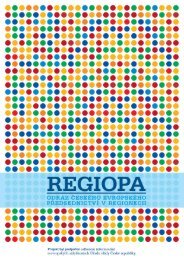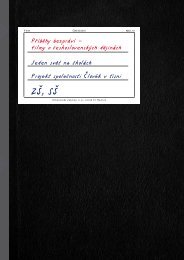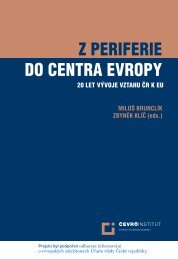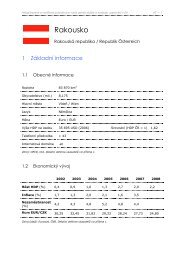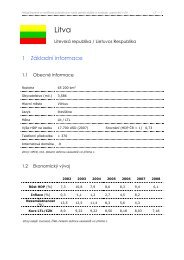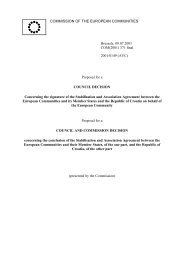CESTA KE SVOBODÄ PÅÃBÄHY BEZPRÃVÃ - Euroskop.cz
CESTA KE SVOBODÄ PÅÃBÄHY BEZPRÃVÃ - Euroskop.cz
CESTA KE SVOBODÄ PÅÃBÄHY BEZPRÃVÃ - Euroskop.cz
- No tags were found...
Create successful ePaper yourself
Turn your PDF publications into a flip-book with our unique Google optimized e-Paper software.
Opposition to the suppression of the Church and religious freedom can be best illustratedby some specific examples. The theologian and priest Oto Mádr returned to Czechoslovakiain 1949 after studying in Rome. He refused to teach at a theological faculty controlledby communists and began organising groups of young Christians. Mass was said at theirmeetings and discussions were held about the situation in the Church and in society. Thesecret police began monitoring Mádr, whom they viewed as someone who was disturbingthe peace. Mádr was arrested in 1951 after an unsuccessful attempt to flee the country,and he was sentenced to life imprisonment a year later. He continued his activistactivities after his release in 1966 and he fought against the regime throughout the entirenormalisation era. Felix Maria Davídek was another priest who constantly opposed thesystem in the interest of freedom and for the benefit of his neighbours. He later becamea bishop in the underground Church. Davídek was ordained as a priest in 1945 and inSeptember of that year he was assigned to the parish of Horní Štěpánov near Boskovice. Anillegal faculty of philosophy was established in 1950 thanks primarily to the Dominicansin Olomouc. Its students officially attended Comenius University, but it was actuallyFather Davídek in Štěpánov who was in charge of their education. He was arrested in April1950, but he escaped and hid from the police before subsequently trying to flee to the West.He was re-arrested and sentenced to 24 years in jail for a series of “criminal acts”. Davídekwas released in 1964 and he soon began to build a secret, parallel Church organisationindependent of the communist regime. This church attracted hundreds of adherents.conditions in their workplaces. In the same period, prisoners rioted in camps at Vojnanear Příbram, Leopoldov and other detention facilities. In June 1956, 12 brave women(including Růžena Vacková and Dagmar Skálová) wrote letters addressed to the UNSecretary-General Dag Hammarskjöld. (They had learned about his planned visit toCzechoslovakia in the newspapers). In the letters, the women outlined what had befallenthem since 1948 and described their situation in prison. Naturally, these letters neverreached their intended recipient. Moreover, the people who wrote them definitely didnot expect their “complaint” to go unpunished.Opposition in the prisons and especially in the streets could not turn the situation aroundin the country and probably could not even influence it in a significant way. By the mid-1950s, the totalitarian regime was already so firmly established in Czechoslovakia thatprobably nobody contemplated rising up against it. Hopes of liberation from the Westhad faded. The groups of saboteurs had either been broken up by the secret police or hadceased their operations. The Communist Party succeeded in decimating the “old” nationalelite and actually finished what the Nazis had started. Ninety percent of those who hadthe courage to rebel (or who could be expected to do so) ended up in jail, work camps,forced labour facilities or on the gallows. Failing this, they fled abroad. Opposition to theestablishment only manifested itself sporadically (if we overlook the situation in prisons),and resistance increasingly shifted to the intellectual sphere.Street demonstrations in 1953 and prison revoltsWith regard to the most brutal phase of Czechoslovak communism, it is necessary tomention at least two examples of opposition to the regime. The first was a mass protest.In 1952, the Communist Party leadership decided to implement currency reform. It wasa strictly confidential decision. This was not surprising because it was to result in theimpoverishment of the entire population. Every Czechoslovak citizen had the right toexchange 300 of the old koruna for 1 new koruna at a rate of 5 : 1. Further sums could beexchanged at a rate of 50 old koruna for a 1 new unit of currency. Workers reacted quicklyand spontaneously to the measure. From 1 to 5 June 1953, strikes were held at 129factories and this developed into anti-government street demonstrations in four largecities. 20,000 people participated in the protests in Plzeň. They occupied the town hall andthe radio station. The protests were only suppressed with the aid of rapidly mobilised armyand police units. According to data received at the time by the Communist Party leadership,the historian Karel Bartošek calculated that 472 strikers were arrested.The second example pertains to revolts and protests in labour camps and prisons. Like the“religious resistance”, this concerned a separate issue, which nonetheless was naturallypart of the “roll call” of conscious opposition to the communist regime. The riotingprisoners were demonstrating for the right of every person to retain their dignity, even ifthey were “class enemies” and “reactionaries” surrounded by armed prison guards.In May 1954, 60 women in Pardubice prison went on hunger strike as an act of defianceagainst the conditions in which they were forced to live. Another hunger strikewas launched in September 1955 and more than one hundred female prisoners tookpart. They were protesting against their poor diet, abuse by prison wardens and bad38 | 39



